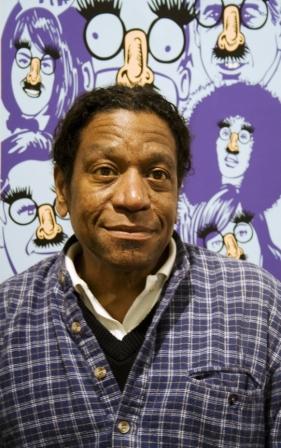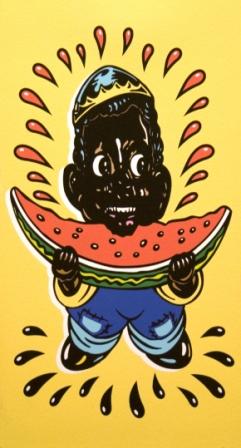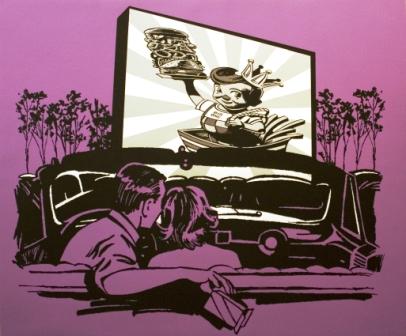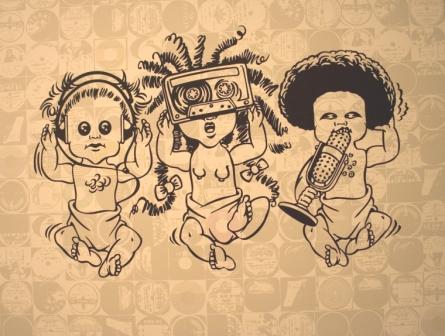In Stereotype
February 22nd, 2013This article originally appeared on February 22, 2013 in The Alamedan. Michele Ellson, editor.

Ken McGhee. Photo: Michael Singman-Aste
“If you write a book about a serial killer, are you condoning his behavior or making a study about what makes a monster?” Ken McGhee stands in the Signature Gallery of the Frank Bette Center for the Arts, surrounded by his art. “What are the origins of this monster that has taken on such a life of its own that it becomes this thing called a ‘stereotype,’ which is for the ages?” McGhee asks. He seeks to answer these questions in his solo show “In Stereotype,” which opened on February 1.
The first piece he created for this series was “Watermelon Boy,” a triptych of a “pickaninny” caricature of an African American eating a watermelon, flanked by panels explaining that watermelon seeds were carried over on slave ships, and that slaves ate watermelon to stay hydrated while picking cotton.

Ken McGhee, “Watermelon Boy”
McGhee, who studied for a BFA in illustration from the Center for Creative Studies in Detroit, describes this as “comic-style, vector, traditional, digital, morphed art that has some kind of message to it other than just shock art octopus heads.” He draws the images by hand, and then loads them into Adobe Illustrator where he redraws them digitally with bold, saturated colors, using the original as a sort of template.
In “Drive In” he takes a shot at “this part of Americana that’s now just this side of being defunct, the Baby Boomer era where you had your barbecue grill, your GI Bill house, and everything was hunky-dory.” In the foreground a man casually discards his empty box of snacks, freeing up his hands to pull his date closer, while on the screen in the background Bob’s Big Boy serves up an onion ring-drumstick-taco-burger inspired by “Super Size Me,” the 2004 exposé of the fast food industry. McGhee was particularly disturbed by that documentary’s scene in which filmmaker Morgan Spurlock gets a “McStomachache” and unswallows his supersized meal in the parking lot.
“They’re doing the math and all these calculations on what is adding up to morbid obesity in this country,” McGhee says. “They were doing a lot of finger pointing towards sugar and trans-fats and major calories and carbs. I’m saying they’re all complicit, and they have this phalanx of attorneys that do this double talk.”

Ken McGhee, “Drive In”
In a spin on Hidari Jingoro’s 17th century carving, McGhee portrays the three wise monkeys who see, hear, and speak no evil as doll-like “music kids” who are controlled by the music industry, in loco parentis. “These record labels would tell you how to sing, and what you can put out and what you cannot,” he says. According to McGhee, his uncle Bob West, who co-wrote the 1970 Jackson 5 hit “I’ll Be There,” had first-hand knowledge of that.

Ken McGhee, “Musikids”
The stereotype in some pieces is more readily apparent than in others, which are more archetypal, or perhaps simply typical. Regardless, McGhee guides us along a spectrum of -isms broad enough to remind us that none of us is safe. In “What’s My Line?” the artist accessorizes a pantheon of iconic figures with Groucho Marx glasses, complete with nose and bushy eyebrows. From Homer Simpson to Einstein, and Angela Davis to a Playboy bunny, McGhee illustrates that an identity not of our own making can easily be thrust upon any of us.
“Ken McGhee: In Stereotype” continues through March 2 in the Frank Bette Center for the Arts’ Signature Salon, located at 1601 Paru Street. The gallery is open from 11 a.m. to 7 p.m. Wednesday-Saturday, and from 11 a.m. to 5 p.m. on Sunday. (510) 523-6957. http://www.frankbettecenter.org/.
Michael Singman-Aste
Postdiluvian Photo
Tags: Alameda, Frank Bette Center for the Arts, Ken McGhee, The Alamedan



Leave a Reply
You must be logged in to post a comment.